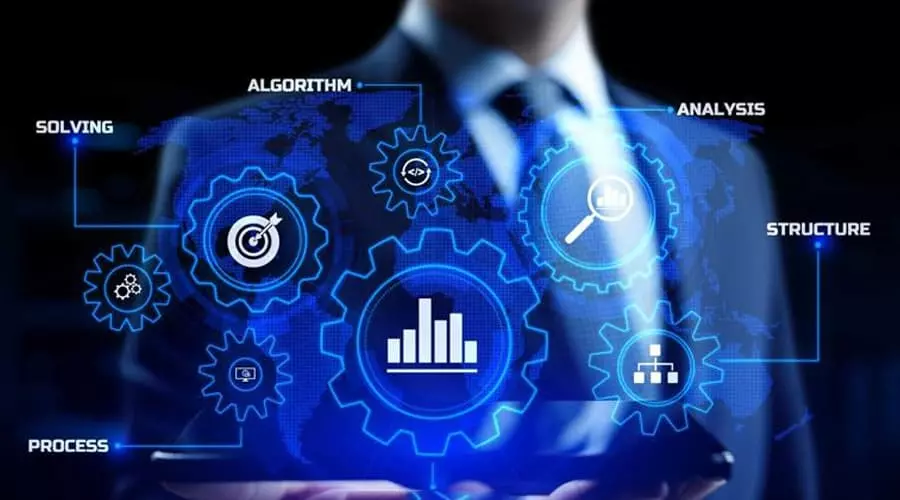Artificial Intelligence Trends for Business Owners
The global artificial intelligence market (AI) value is forecast to make up $267 billion by 2027, according to Fortune Business Insights. More and more businesses are adopting AI to cut operational costs, boost efficiency, raise more revenue, and improve customer experience.
This article discusses the top artificial intelligence trends in business, such as AI in video surveillance and no-code AI platforms.
Artificial Intelligence Trends in Business

Business and technology are intertwined. And this interconnectedness is becoming tighter and tighter. Let’s take AI. It’s developing and becoming more commonplace in our daily lives. For example, many feel the household presence of Amazon’s virtual assistant Alexa in their homes.
Given the business world is constantly evolving, companies need to follow modern tech trends to keep up with the competition in their fields. According to the December 2021 survey by global management consulting company McKinsey & Company, at least one function at 56% of organizations already use AI. This number is up from 50% in 2020.
So how is AI used in business?
AI in Video Surveillance
AI in video surveillance focuses on abnormal behavior patterns to detect suspicious activity. As a result, organizations can create more secure public and private spaces by identifying potential threats. For example, businesses in the fields of logistics, retail, and manufacturing often rely on this type of AI-driven video solution.
The U.S. Bureau of Labor Statistics reports that the number of surveillance camera installations in the country reached 85 million in 2021 from 47 million in 2015, accounting for 80% growth.
AI in Voice Recognition
Voice recognition-related technologies determine the identity of a person. For example, Walmart’s customers can use voice ordering for online groceries through Google Assistant. The smart assistant remembers what products customers prefer and creates customized item recommendations taking into account their Walmart shopping history.
According to Statista, the global voice recognition tech market made up about $10 billion in 2020 and is expected to reach almost $30 billion in 2026.
AI in Biometric Face Recognition
Technologies using biometric face recognition collect each person’s unique biometric data, such as people’s faces and facial expressions. The data is used to identify, verify, or authenticate a person.
For example, many law enforcement agencies worldwide turn to biometric software to scan faces in closed circuit television (CCTV) footage. CCTV records people’s images in certain public places such as town centers, roads, airports, and on public transport. CCTV footage recording helps companies prevent crime and reduce security costs.
According to Statista, the facial recognition market accounted for about $5 billion in 2021 and is anticipated to reach $12.67 billion by 2028.
AI in Real-Time Video Processing
AI is also used in real-time video processing tools, which are increasingly in demand worldwide. The reason is that video conferencing is gaining more popularity with the uptick in remote work. In this case, AI helps eliminate problems encountered in real-time such as poor image quality and inappropriate exposure.
GlobeNewswire reports that the global video conferencing market is anticipated to reach $22.5 billion by 2026 from $9.2 billion in 2021.
AI in Chatbots
AI is transforming the way companies connect and interact with their customers. Specifically, companies leverage AI-driven chatbots or chatterbots to improve their customer relationships by automating admin tasks and reducing the amount of manual work.
A chatbot is a software application companies use to conduct an online chat conversation through text or text-to-speech to deliver direct contact with a live human agent.
For example, in the healthcare space, chatbots help organize appointments and send patients reminders concerning medications they take. Moreover, they help deliver targeted messages and personalized offers.
Statista reports that the global chatbot market is expected to reach $454.8 million in 2027, up from $40.9 million in 2018.
AI in Content Creation
Many companies already use AI-based software for content creation. Specifically, such software creates blog posts, social media content, eBooks, landing pages, emails, and product descriptions. Moreover, there is also a shift toward audio and video content. Copy.ai and Jasper are two of the popular AI tools for content creation.
The use of AI by marketers increased from 29% in 2018 to 84% in 2020, as Salesforce Research’s latest State of Marketing Study shows. Namely, 70% of top marketers have implemented an AI content strategy.
AI in Quality Assurance (QA) and Inspection
Quality assurance refers to a systematic process of determining if a product or service meets specified requirements. Inspection is about careful evaluation aiming to meet customer requirements and prevent defective products from being distributed.
Specifically, AI in QA helps detect product deficiencies, identify defects of mechanical and car body parts, enables baggage screening and aircraft maintenance, and inspects nuclear power stations. Thus, AI plays a unique role in new product development.
According to Statista, 59% of recent survey respondents in the manufacturing industry say that quality control is an essential use case for AI.
AI in Customer Relationship Management (CRM)
With customer relationship management tools, businesses organize, automate, and synchronize all aspects of their interaction with customers. AI-based CRM solutions enable customer databases to self-update, automate processes, and add contacts to the correct list. As a result, and improve their services or products.
According to Statista, the adoption of AI in customer relationship management activities in the U.S. is projected to bring an additional $394 billion to the sector in the next five years.
AI for Data Organization
Data is the new oil. Companies collect large amounts of data, and AI helps them sort and segment it. In addition, it rates the credibility of the data source. As a result, companies gain further insight into their customers, competitors, and industries to make wiser, more educated, and data-driven decisions with the help of AI.
According to GlobeNewswire, 61% of business executives focused on innovation are using AI to enjoy more opportunities in data that wouldn’t otherwise be possible.
AI in Supply Chains and Cost Reduction
Inventory drones and driverless machines in supply warehouses were once a concept, and today they’re a reality. Companies use them to improve timing and efficiency and cut costs.
Specifically, companies leverage AI to automate the supply chain and shipping processes, thus improving agility and accuracy. This can’t be observed with manual processes. Thus, AI is changing the face of supply chain management.
According to Forbes, AI in the logistics and supply chain market is anticipated to reach $6.5 billion by 2023, growing with a compound annual growth rate (CAGR) of 42.9% from 2017 to 2023.
AI in the Human Workforce
An increasing number of businesses turn to AI to tackle simple and repetitive tasks, leaving more complex work to the human workforce. For example, the human resource (HR) and recruitment sectors are expected to witness dramatic changes due to the implementation of AI.
According to Statista, about 74% of participants in a 2019 survey stated that the adoption of intelligence automation (IA) would vividly impact 11% to 50% of their current workforce in their organizations.
No-Code AI Platforms
No-code AI is a code-free technology enabling non-AI experts to implement their ideas and test them without the help of AI experts. Google Cloud Auto ML, Google ML Kit, and SuperAnnotate are three of the top no-code AI platforms these days.
These platforms simplify tasks. Specifically, they provide fast implementation, lower cost development, and ease of use. According to Gartner, 70% of new applications that enterprises develop are expected to use low-code or no-code technologies.
AI Tools for a Small Business
Modern tech powered by AI solutions is moving forward with tremendous advances. Advocates of AI promote a future with autonomous cars, robots, predictive analytic software, natural language processing (NLP) for reports in media, virtual educational tutors, AI assistants, and chatbots.
For businesses to continue innovating with AI, data is vital for enabling artificial intelligence to learn effectively. That’s why companies increasingly rely on data to carry out effective business analytics and improve decision-making. For example, companies use automated machine learning (AutoML) to simplify AI-powered decision-making.
Automated machine learning is the process of task automation when applying machine learning to solve problems related to your business. Machine learning is a type of AI allowing software applications to become more accurate at predicting outcomes.
Specifically, you can use AI tools to get insights from your data across multiple sources to boost your business analytics. For instance, you can rely on a real-time decision-making tool that delivers fast results and decisions without requiring coding experience.
With this tool, you can enjoy real-time models, outcome estimation based on your uploaded data, and seamless integration with your current system.
Sum Up
The role of artificial intelligence in the world of business is growing. Therefore, keeping up with artificial intelligence trends in business is critical. Some of the hottest trends include AI in video surveillance, biometric face recognition, and no-code AI platforms. Consider using an AI-driven tool to improve your business analytics.
Table of Contents
- Artificial Intelligence Trends in Business
- AI in Video Surveillance
- AI in Voice Recognition
- AI in Biometric Face Recognition
- AI in Real-Time Video Processing
- AI in Chatbots
- AI in Content Creation
- AI in Quality Assurance (QA) and Inspection
- AI in Customer Relationship Management (CRM)
- AI for Data Organization
- AI in Supply Chains and Cost Reduction
- AI in the Human Workforce
- No-Code AI Platforms
- AI Tools for a Small Business
- Sum Up



